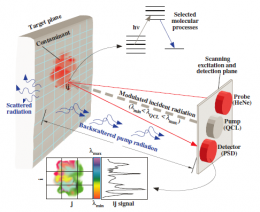Standoff sensing enters new realm with dual-laser technique

(PhysOrg.com) -- Identifying chemicals from a distance could take a step forward with the introduction of a two-laser system being developed at the Department of Energy's Oak Ridge National Laboratory.
In a paper published in the Journal of Physics D: Applied Physics, Ali Passian and colleagues present a technique that uses a quantum cascade laser to "pump," or strike, a target, and another laser to monitor the material's response as a result of temperature-induced changes. That information allows for the rapid identification of chemicals and biological agents.
"With two lasers, one serves as the pump and the other is the probe," said Passian, a member of ORNL's Measurement Science and Systems Engineering Division. "The novel aspect to our approach is that the second laser extracts information and allows us to do this without resorting to a weak return signal.
"The use of a second laser provides a robust and stable readout approach independent of the pump laser settings."
While this approach is similar to radar and lidar sensing techniques in that it uses a return signal to carry information of the molecules to be detected, it differs in a number of ways.
"First is the use of photothermal spectroscopy configuration where the pump and probe beams are nearly parallel," Passian said. "We use probe beam reflectometry as the return signal in standoff applications, thereby minimizing the need for wavelength-dependent expensive infrared components such as cameras, telescopes and detectors."
This work represents a proof of principle success that Passian and co-author Rubye Farahi said could lead to advances in standoff detectors with potential applications in quality control, forensics, airport security, medicine and the military. In their paper, the researchers also noted that measurements obtained using their technique may set the stage for hyperspectral imaging.
"This would allow us to effectively take slices of chemical images and gain resolution down to individual pixels," said Passian, who added that this observation is based on cell-by-cell measurements obtained with their variation of photothermal spectroscopy. Hyperspectral imaging provides not only high-resolution chemical information, but topographical information as well.
More information: The paper, titled "Pump-probe photothermal spectroscopy using quantum cascade lasers," is available at: iopscience.iop.org/0022-3727/45/12/125101/article
Provided by Oak Ridge National Laboratory


















